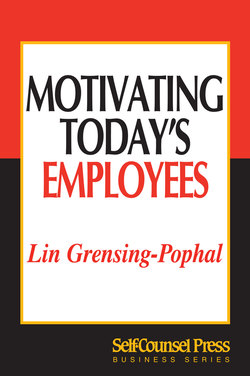Читать книгу Motivating Today's Employees - Lin Grensing-Pophal - Страница 25
На сайте Литреса книга снята с продажи.
Motivators for the 21st Century
ОглавлениеAs the labor market continues to tighten, innovative companies are reaching deeper and deeper into their bag of incentives to recruit, retain and motivate employees. Interestingly, it is not the offer of higher salaries or stock options that encourages most workers. In fact, one of the most desired benefits for many workers is work/life balance, according to a 2000 study by Wirthlin Worldwide, which was commissioned by Xylo, a company that helps clients motivate employees through the establishment of work/life programs.
In the survey of 1002 workers, 71 percent cited reasons other than salary and bonuses as factors that influence their job satisfaction and motivation. Four factors stood out when employees were asked to indicate what caused them to feel satisfied or motivated on the job:
• 29 percent said additional perks, benefits, and employee discounts
• 25 percent said a good salary and bonuses
• 23 percent said a work environment that is fun and enjoyable
• 22 percent said recognition and respect for work performance
The results of this study are consistent with what other researchers have found. According to another study by the Radcliffe Public Policy Center in Cambridge, Massachusetts, white-collar workers value time more than money. This is especially true in workers between the ages of 20 and 39. Family time topped the list of workplace priorities for 82 percent of men and 85 percent of women aged 20 to 39 in the study.
Results of these studies aside, however, it’s important to keep in mind that no two people are the same. No two of your employees are the same. Consequently, no single motivator is going to work with all of your employees. Some employees — and often these are lower-level employees — will be positively influenced by money. Others — those with family commitments — may be motivated by time off or flexible work scheduling. Still others may crave independence and the ability to be involved in decision-making. To motivate effectively, you need to know more than what the motivators are. You need to know which motivators will work with which people.
The needs and values of today’s workforce are very different from the needs and values of the workforce 50 years ago — or even ten years ago. Today’s workers are better educated, less interested in following orders, more loyal to themselves than to the company, and more concerned about meeting their own needs.
Furthermore, today’s employees are impatient. They are not willing to wait years for a pay increase, a promotion, or new opportunities. They will not bide their time in an organization if they do not feel they are being valued or given the opportunities and benefits they demand.
This presents a major challenge for employers and managers. The current generation of workers can be very difficult to motivate. According to the Bureau of Labor Statistics, the number of people working or looking for work is projected to increase by 17 million between 1998 and 2008, reaching 155 million. This growth will be affected by the aging of the baby-boom generation (those born between 1946 and 1964). At the same time, the number of persons in the labor force between the ages of 25 and 44 is projected to decrease.
As these dramatic shifts are taking place, the number of management jobs will fall sharply. Promotions may not be available.
What happens when an employee works at the same job, year after year, with no chance for promotion? He or she becomes dissatisfied and, eventually, non-productive. To maintain job satisfaction under these circumstances, employers must come up with creative ideas for employee motivation. To do this, they must first determine what motivates their employees.
